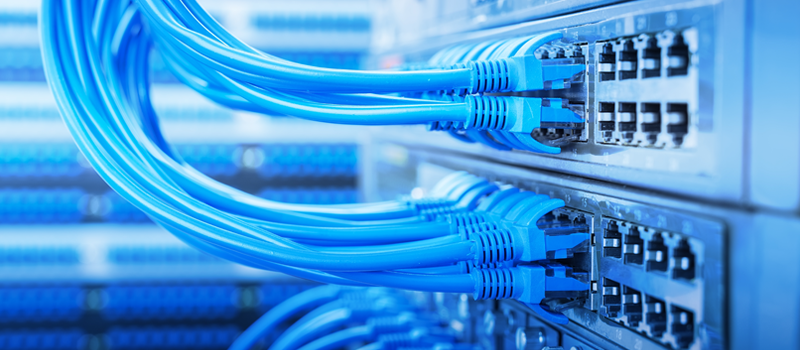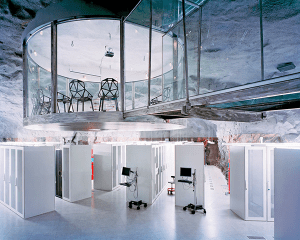
From repurposing abandoned bunkers and natural caves to creating man-made underground spaces, the telecommunications industry is no stranger to building underground facilities. The North American Aerospace Defense Command (NORAD), originally built to protect communications systems against attack, moved into an underground bunker in the Cheyenne Mountain range in the early ‘60s.
Although building underground data centers has never been seen as a mainstream option, that may be changing, especially in the Pacific Rim.
 A Space Issue
A Space Issue
Around the Pacific Rim, the idea of going underground is being seriously considered. For example, Singapore continues to be rated the leading data center location to site a data center due to factors such as business climate, access to energy, political stability, and Internet bandwidth. However, in Singapore, data center developers and operators must contend with a lack of land available for development – and the correspondingly high-cost of available space. Underground data centers allow the compact, island nation to continue to expand.
Space constraints cause problems for other Pacific Rim countries as well. In 2013, Google pulled the plug on a planned 2.7-hectare site inside the Tseung Kwan O Industrial Estate, citing the lack of available land for expansion. (A data center has since been built in that complex.) Probably not coincidentally, the Hong Kong government started exploring the use of man-made underground caverns for data centers and other commercial purposes at about the same time.
Meanwhile, across the Pacific, developers have unveiled the West 7 Center, Los Angeles’ largest underground data center to date. The owners of the facility hope to serve the needs of IoT providers seeking data storage for cloud services as well as Asian telecommunications companies looking to enter the U.S. market.

Attribution: wired.com
Keeping it Cool
Optimized land usage isn’t the only reason developers are considering underground options. Power consumption and cooling issues are top of mind for many data center operators, especially in areas where summer heat waves can get intense.
Australia’s energy rating body determined that data centers consumed nearly 4 percent of the country’s electricity in 2013. Estimates in the United States continue to hover around 2 percent. As reported by Forbes, the global figure was approximately 3 percent in 2017, but with the increasing hunger for storage space and processing power, consumption is expected to double every four years.
Many data center operators try to cut down on energy consumption by opening windows when outside temperatures reach an acceptable range, but in tropical areas like Singapore, cracking a window just won’t cut it. Even in subtropics and cooler climates, humidity and pollution can still affect equipment. Plus, open windows can present a safety risk in high-rise buildings and a security risk for ground-floor data centers.
Going underground can decrease the energy consumed through cooling. Underground temperatures are naturally low. Iron Mountain, a U.S. developer of underground data centers, claims a year-round ambient temperature of 52°F (11°C). Of course, servers produce significant heat, raising those temperatures to uncomfortable levels for both man and machine, so proper ventilation is necessary.
Microsoft is even testing self-contained, unmanned undersea data centers that decrease cooling costs and lag time to coastal cities. Initial deployments are in Scotland’s northern islands, but this is a development worth keeping an eye on for cooler coastal regions around the Pacific Rim.
Playing it Safe
With cybersecurity incidents hogging the headlines, it’s easy to forget about the importance of physical security. Tencent is building a massive data center in the hills of Guizhou, China where it plans to house its most sensitive data. The data center plans call for features that are more reminiscent of a cold-war era bomb shelter than a modern data center, including blast doors that are designed to withstand most physical attacks. In addition, each entryway will be equipped with high-tech security features including security robots, drones, and facial recognition.
One of the myths of underground data centers is that they protect against electromagnetic pulses (EMPs). They do not unless properly shielded. Nevertheless, for areas experiencing high levels of political and social unrest, going underground may offer a solid defense against more brute force attacks.
Here is an area where data center operators might do well to learn from other industries like energy. In 2013, unknown attackers cut a series of fiber-optic telecommunications cables and then proceeded to open fire on 17 electrical transformers in the Metcalf substation just outside of San Jose, California, doing more than USD 15 million in damage.
While the culprits were never caught and their motives remain a mystery, military investigators told federal regulators that the attack has the hallmarks of a professional operation. The incident has since been labeled domestic terrorism and led to increased vigilance on the part of the energy industry. Building underground substations is one way the industry is mitigating the risk. Unfortunately, like the Metcalf substation, large, above-ground data centers could present an attractive target to foreign or domestic operators looking to do damage to a region’s economy or a specific business.
Underground data centers can also be more resilient against a common attacker with a less malicious intent: squirrels. Believe it or not, squirrels are a force of nature, accounting for as much as 17 percent of all cable damage according to one multinational telecom. Finally, going underground can help make data centers more resilient against fire, windstorms, and other surface-level natural disasters.
Necessity Drives Innovation
Care needs to be taken when selecting a site as underground data centers can impact the local environment. Hong Kong, for example, will need to tackle a challenge with water-table levels for man-made underground facilities to be feasible. Data center operators across the Pacific Rim will certainly have to consider the potential of seismic activity before locating new facilities underground.
The human factor needs to be considered as well, at least until self-healing data centers that operate autonomously become a reality. Our species wasn’t designed to live life in dark spaces, and some of us are better at adapting to these environments than others. For telecoms looking to locate their data centers underground to be able to attract the level of talent they need, lighting, ventilation, and other amenities may need to be provided to make the data center an inviting place to work across the spectrum of humanity.
These challenges are not insurmountable, but until recently, the relatively moderate growth in data center capacity requirements hasn’t necessitated a focus on them. However, according to tech-entrepreneur and Cloudscene’s founder Bevan Slattery, “It’s no secret that the Asia Pacific region is the fastest-growing data center market in the world right now. Operators are in an aggressive race to meet market demand. Global public cloud providers are all making their presence known in the region, and new opportunities supported by foreign and domestic investment are having a huge impact on the industry. I can’t see the Asia Pacific market slowing down anytime soon.”
On the other side of the Pacific, Seattle and Silicon Valley continue to be two of the most active data center markets in the U.S. With challenges such as lack of space, the need to decrease power consumption and the increasing risk from malicious actors (and squirrels), underground may become not just mainstream, but a preferred option among data center developers of the future.







